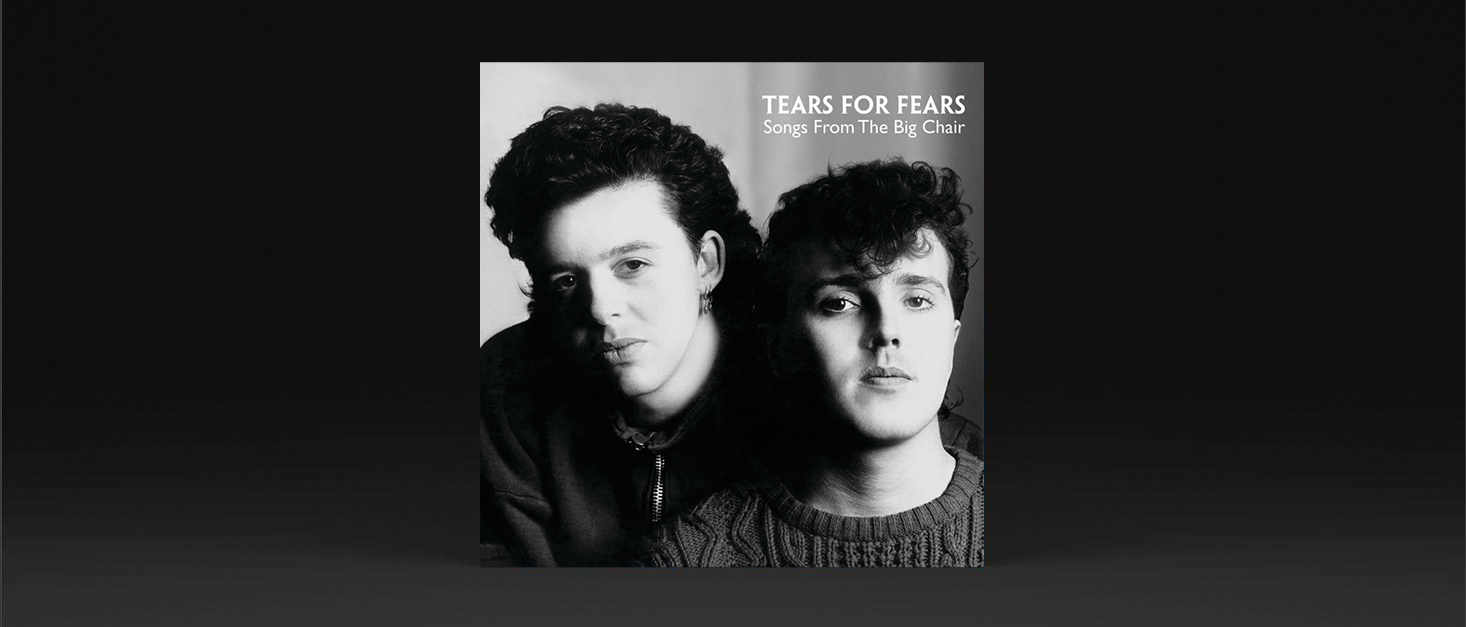
Revisiting Tears For Fears’ Songs From The Big Chair
Filled with infectious pop anthems, Tears For Fears' 1985 album combines stellar musical performances with clever songwriting, innovative production and rousing choruses. In the latest in a regular series reflecting on classic albums from decades past, we take a look at its distinctive sound and most memorable moments
Tags: Music,Synth pop was one of the defining musical trends of the 1980s. The first half of the decade saw an explosion of synthesiser duos, from Orchestral Manoeuvres in the Dark to Blancmange, Yazoo and the Pet Shop Boys, as a new generation of electronics allowed one musician to create a broad range of sounds while another focused on vocals.
So it was with Bath-based Tears For Fears (Roland Orzabal and Curt Smith), who released the audaciously catchy single ‘Mad World’ in October 1982. Just like the Pet Shop Boys’ ‘West End Girls’, which came out 18 months later, 'Mad World’ received a lot of air time on John Peel’s BBC Radio 1 night time show, indicating to the era’s student hipsters that Tears for Fears were the very epitome of 80s indie cool.
The following year, Smith and Orzabal released The Hurting – an album that didn’t disappoint their newfound fans. It had plenty of stories about adolescent angst and alienation, set to infectious melodies and backed by a cold drum machine beat. Although not quite on par with the decade’s finest albums, it was a solid showing, and bode well for the duo's future.
"This new album sounded more polished and varied than the group's first long-player"
Tears For Fears went on to launch a smash hit single, ‘Shout’, in 1984, which rang out from transistor radios on both sides of the Atlantic for what seemed like an eternity. Then came Songs From The Big Chair. Released on February 25, 1985, this new album sounded more polished and varied than the group’s first long-player. Smith and Orzabal had obviously done a lot of thinking about where they were taking their songwriting, creating an album that was conspicuously less teenage bedsit-bound than its predecessor, and more focused on the quirkiness of modern life. (Its title is a nod to the 1976 film Sybil, whose lead character only feels safe in her psychologist’s chair.)
Recorded at Somerset’s Wool Hall studio in 1984, it saw Smith and Orzabal harness an obvious flair for big choruses. Smith later commented: "We were very introverted on The Hurting; it was a very dark album. We found the need to be more outgoing on Big Chair, and the use of big guitars and the things that we shied away from before allowed us to do that."
"Smith and Orzabal moved away from a purely synth pop sound, bringing in pianos, saxophones, and lead and bass guitars"
The production, courtesy of Chris Hughes, was absolutely state-of-the-art for the time. In the early to mid-80s, rapid changes in synthesisers and samplers meant that albums which had sounded fresh and modern just a few years earlier had quickly dated. For Big Chair, Smith and Orzabal moved away from a purely synth pop sound, bringing in pianos, saxophones, and lead and bass guitars. Touring musicians Manny Elias (on drums) and keyboardist Ian Stanley provided extra layers and texture. This, in turn, allowed Orzabal to be more ambitious with his arrangements.
Big Chair kicks off with ‘Shout’, which remains one of the most catchy singles to emerge from the 1980s. On the face of it, it’s a less intricate – and arguably more poppy – production than some of the tracks found on The Hurting, such as the ambitious ‘Mad World’. The song kicks straight into the chorus, which gains much of its power by simple repetition backed up with powerful electronic percussion that comes heavily compressed. This is overlaid with a minor key synthesiser glide that gives the song a sultry feel. As it develops, the production becomes more complex, with a sampler playing a backing melody line, multitracked vocal overdubs and a guitar solo.
The track is emblematic of where 1980s power pop was headed, with almost no acoustic instruments
By contemporary standards, ‘Shout’ sounds very much of its time, yet it’s an ambitious piece of 80s pop production and song craft. ‘The Working Hour’, by contrast, has a more spacious, laid back, almost mid-Atlantic feel, with Orzabal taking the lead vocal, and prominent saxophone work playing off him, plus great swathes of atmospheric keyboards that wouldn’t disgrace a Simple Minds album of the same period. Again, the drum work plays a major part in giving the song power, but is less compressed here. These electronic percussion sounds simply weren’t available when The Hurting was made, and they lent the production a strikingly modern quality.
‘Everybody Wants to Rule the World’ is arguably even more infectious than ‘Shout’, and follows a similar formula, with a soaring chorus line and relatively subdued verse structure. It shares the same compressed, shuffling electronic percussion that powers the song along, and heavily processed electric guitar arpeggios to fill out the sound. Curt Smith’s powerful vocal lead is further embellished by huge amounts of reverb. The track is emblematic of where 1980s power pop was headed, with almost no acoustic instruments, and a huge, overblown and dense sound that made Tears for Fears’ debut album sound positively minimalist in comparison. "Lyrically, it was also our move away from introspection, to looking at things globally", Orzabal later explained.
‘Mother’s Talk’ was the album’s first single, heavily reworked with a more dense production and a Level 42-style bassline. Producer Chris Hughes throws everything at it, from dark, hard-hitting industrial beats to string samples from a Barry Manilow song. Brash and relentless, it sounds a little out of place on an album that generally has a far more sophisticated feel. ‘I Believe’, meanwhile, couldn’t be more different – simpler and purer, it could have sat happily on the band’s first album. It’s a classy, soulful, thoughtful ballad with an unusually (for this album at least) sparse production. Stylistically, there are shades of songwriter Robert Wyatt.
There’s a real grandness to the sound, and a stellar vocal performance from Orzabal
‘Broken’ ups the tempo: a dense, short and heavily compressed track, it’s laced with thumping drum machine snare and bass drum work, pulsating bass guitar, and Smith’s plaintive vocals. This takes the listener straight into one of the album’s highest points, ‘Head over Heels’ - an epic piece of synth pop with a killer melody and what was then cutting edge production.
This track’s distinctive intro riff appears throughout ‘Broken’, but is fully realised with a striking opening hook line, backed by a beautiful string swell that’s followed by reverb-laden picked guitar. There’s a real grandness to the sound, and a stellar vocal performance from Orzabal, which alternates from single tracked to double tracked to give it extra emphasis (listen out for the long delay - a popular feature in the 80s). Interestingly, the producer uses a real bass guitar, often playing slides right at the top of its range, together with programmed drums. This gives added intensity to the mix, which is further bolstered by rhythmic keyboard work from a Yamaha DX7 synth. Any decent hi-fi system will be able to pick out the multitracked male backing vocals alongside a single female vocalist on the closing chorus.
Bursting with infectious, ‘singalong’ pop anthems, it is also an extremely clever and thoughtful album
‘Listen’ is a suitably high note to end this excellent album on. It begins with chiming keyboards set inside a spacious, expansive acoustic, and continues with dour lead vocals from Smith, playing between long passages of ambient synthesiser work and Orzabal and Marilyn Davis’s vocal phrases. One of the least compressed and mixed-for-FM radio tracks here, it showcases the excellent sound that Big Chair is capable of. Sadly though, despite it being an absolute tour de force production wise, the mastering on some other tracks leaves much to be desired, and the result is that this is a patchy sounding album.
It would be hard to write the history of 1980s pop music without including Songs from the Big Chair. It was both a huge commercial success – reaching number one on the US Billboard 200 album charts, and achieving multi-platinum status in both the UK and the US – and a peerless example of the brilliantly crafted, superbly produced popular music of that decade. Bursting with infectious, ‘singalong’ pop anthems, it is also an extremely clever and thoughtful album. Despite garnering surprisingly limited critical acclaim upon its release, it could be heard blasting from pub jukeboxes and car radios across the U.K. for what seemed like years on end.














